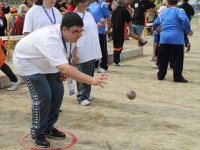How to Become a Socially Inclusive School
In its comprehensive case study report on socially inclusive schools, Special Olympics' Project UNIFY identified the common factors across schools that had created a bridge from social inclusion programs to a genuinely positive school climate. The case study findings are here, and I'm also going to share with you key lessons learned that reflect my own work in fostering inclusive settings.
What Does One See in a Truly Socially Inclusive School?
There are some schools where there is a philosophical commitment to inclusion but strategies are needed. In other schools, the commitment is not deep or well articulated, and strategies, if present, are sporadic. Most schools fall into the second category, at best, and it is with those schools in mind that the following guidance is offered:
Suggestion #1:
Start with some tangible, non-threatening activities by those who are genuinely interested in being involved.R-Word Campaign. Don't worry about starting small. Success builds from true enthusiasm.
Suggestion #2:
Be sure the efforts are student-centered. Youth empowerment-both those youth with special education classifications and those who are not so labeled- is a common factor in truly inclusive schools. This involves engaging students in developing, implementing, and sustaining a wide range of inclusive activities.
Suggestion #3:
Educate students and all staff about social inclusion and its ethical importance in formal and informal school settings. This means the classroom, the bus, and the lunchroom.
Suggestion #4:
Social inclusion is woven into the fabric of the school. At some point, a statement must be made by school leadership that social inclusion is of preeminent value and violations are not acceptable. This will provide many opportunities for constructive education, as it will take some time for the student body and many staff to understand all of the situations in which inclusion -- respectful and dignified treatment of all others -- should apply.
Suggestion #5:
Social inclusion is not about some students "helping" others and some students being "helped." It is about all students finding meaningful ways to contribute (which means all situations are not necessarily reciprocal but all students must have involvement as contributors to others, regardless of ability level).
Suggestion #6:
Leadership must be cultivated and expanded beyond a small number of devoted individuals. Reach out broadly into all aspects of the school population, including staff, and community partners. Definitely reach out to your Statewide or National Special Olympics organizations. And of course, include students of varied abilities within the leadership structure. Shared and inclusive leadership is a fundamental aspect of a truly inclusive school.
Suggestion #7:
Students, teachers, and administrators engage in ongoing reflective processes to review efforts, plan, and engage in continuous improvement. Use formal and informal methods to get a wide range of opinions.
Suggestion #8:
Administrative support must be visible and tangible at the building and district levels. This will take the form of budget allocations, time for planning and activities, regular discussion of inclusive efforts at faculty and grade level meetings, and regular updates to the Board and community newsletters about the progress being made in social inclusion and improved school climate.
Challenges Schools Face and Must Address
Moving Too Quickly
Start from where you are and, as noted earlier, do not hesitate to start small. You are building a foundation for an inclusive school for the long-term, not simply putting together a program.
Too Proud To Borrow
Never hesitate to learn from what other schools are doing, especially schools similar to yours. Originality is overrated. Besides, you will ultimately have to adapt any strategy to your own particular circumstances. Project UNIFY has many resources that can be used or adapted, including Get Into It, a set of online, downloadable resources for educators of all grade levels, for in-school or after-school settings, that focus on youth empowerment, mutual respect, understanding, and friendship.
Hesitation to Empower Students
Student engagement -- on the part of both those with special education labels and those not so labeled -- is essential. Don't be afraid to give students significant responsibility, albeit with supervision, guidance, and training to help them grow. One middle school we are aware of had a week of leadership training for all students to start the school year, making a statement that leadership was expected of everyone. Don't wait for volunteers -- encourage some students who might otherwise not come forward, to ensure a high degree of diversity.
Lack of Commitment to a Buddy Approach
Using buddy approaches is a major way to generate success. This includes staff as well as students. Moving into uncharted territory is easier with a partner. And there is no rule that says buddies must be in pairs. Buddy groups of three or four can be quite viable, as long as lines of communication and responsibility are clear.
Failure to Change Policies and Allocate Resources Needed for Success
Are there current policies that will make social inclusion strategies more difficult to implement? Is there adequate planning time for staff, students, and community partners? Is the extra work that some staff may be taking on being recognized? Is there a plan to assess the school climate, and overall progress, as plans are implemented? Are there regular opportunities for a frank review of the process, including at Faculty and Grade Level meetings? As programs are being considered, such as UNIFIED Sports or P.E. or an R-Word Campaign, what resources are needed, and by whom, to ensure true collaboration and success?
There are few challenges that have not already been overcome by a school like yours, somewhere. Special Olympics Project UNIFY resources are available to help you on the path to successfully integrate social inclusiveness in your school, for the benefit of everyone. For more information, you can contact Andrea Cahn, Senior Director, Special Olympics Project UNIFY.
How has your school promoted inclusion of students with special needs? What have been the challenges and the successes? Please share in the comment section below.
